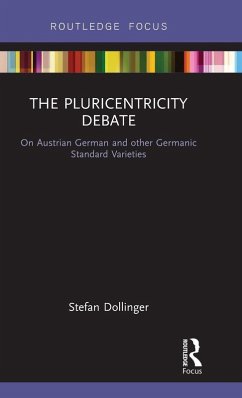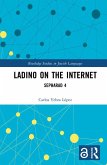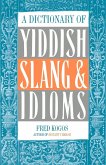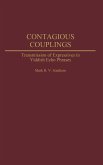- Gebundenes Buch
- Merkliste
- Auf die Merkliste
- Bewerten Bewerten
- Teilen
- Produkt teilen
- Produkterinnerung
- Produkterinnerung
This book unpacks ongoing debates on pluricentricity, an idea implicit to the study of World Englishes which considers differing standards or local norms in a language's national varieties, with a focus on the emergent counter-perspective of "pluri-areality" as exemplified in the German language.
Andere Kunden interessierten sich auch für
![Ladino on the Internet Ladino on the Internet]() Carlos Yebra LópezLadino on the Internet171,99 €
Carlos Yebra LópezLadino on the Internet171,99 €![The Canvas and Other Stories The Canvas and Other Stories]() Salomea PerlThe Canvas and Other Stories18,99 €
Salomea PerlThe Canvas and Other Stories18,99 €![The Big Coloring Book of Jewish Slang The Big Coloring Book of Jewish Slang]() Anna NadlerThe Big Coloring Book of Jewish Slang19,99 €
Anna NadlerThe Big Coloring Book of Jewish Slang19,99 €![A Dictionary Of Yiddish Slang & Idioms A Dictionary Of Yiddish Slang & Idioms]() Fred KogosA Dictionary Of Yiddish Slang & Idioms13,99 €
Fred KogosA Dictionary Of Yiddish Slang & Idioms13,99 €![Jews Without Yellow Stars Jews Without Yellow Stars]() Hersh SmolarJews Without Yellow Stars25,99 €
Hersh SmolarJews Without Yellow Stars25,99 €![Jews Without Yellow Stars Jews Without Yellow Stars]() Hersh SmolarJews Without Yellow Stars35,99 €
Hersh SmolarJews Without Yellow Stars35,99 €![Contagious Couplings Contagious Couplings]() Mark R. V. SouthernContagious Couplings89,99 €
Mark R. V. SouthernContagious Couplings89,99 €-
-
-
This book unpacks ongoing debates on pluricentricity, an idea implicit to the study of World Englishes which considers differing standards or local norms in a language's national varieties, with a focus on the emergent counter-perspective of "pluri-areality" as exemplified in the German language.
Produktdetails
- Produktdetails
- Verlag: Routledge
- Seitenzahl: 152
- Erscheinungstermin: 3. Juni 2019
- Englisch
- Abmessung: 222mm x 145mm x 12mm
- Gewicht: 331g
- ISBN-13: 9780367143572
- ISBN-10: 0367143577
- Artikelnr.: 56960292
- Herstellerkennzeichnung
- Libri GmbH
- Europaallee 1
- 36244 Bad Hersfeld
- gpsr@libri.de
- Verlag: Routledge
- Seitenzahl: 152
- Erscheinungstermin: 3. Juni 2019
- Englisch
- Abmessung: 222mm x 145mm x 12mm
- Gewicht: 331g
- ISBN-13: 9780367143572
- ISBN-10: 0367143577
- Artikelnr.: 56960292
- Herstellerkennzeichnung
- Libri GmbH
- Europaallee 1
- 36244 Bad Hersfeld
- gpsr@libri.de
Stefan Dollinger is Associate Professor at UBC Vancouver, specializing in historical linguistics, sociolinguistics and linguistic border studies. He is the author of New-Dialect Formation in Canada (2008) and The Written Questionnaire in Social Dialectology (2015), and Chief Editor of the Dictionary of Canadianisms on Historical Principles - www.dchp.ca/dchp2 (2017).
Table of Contents
List of tables
List of illustrations
Preface
Acknowledgements
Terminological Note
1 The problem
1.1 What is pluricentricity?
1.2 What is pluri-areality?
1.3 Pluricentricity in the world
1.4 Pluricentricity in the Germanic languages
1.5 An outline of the book
2 Standardizing German: concepts and background
2.1 Contiguous borders vs. sea borders
2.2 What's in a name?
2.3 The standardization of written German
2.4 Abstand, ausbau language and "roofing"
3 The international pluricentric model
3.1 English
3.2 Northern Germanic
3.3 Belgian Dutch (Flemish) and Dutch Dutch
3.4 Luxembourgish
4 The German "pluri-areal" model
4.1 Dialectological context
4.2 Pluricentric and monocentric models of German
4.3 The Upper Austrian - Bavarian border
4.4 A pluricentrist turned pluri-arealist
5 The case against pluricentricity
5.1 Pluricentricity and the Österreichisches Wörterbuch (ÖWB)
5.2 The charge of ideology vs. enregistering ideology
5.3 The pluri-arealist bias
5.4 Reinterpreting Auer (2005)
5.5 Pluricentricity: outdated in a borderless Europe vs. homo nationalis?
6 The case against "pluri-areality"
6.1 Demystifying pluri-areality = "geographical variation"
6.2 A-theoretical empiricism
6.3 The Axiom of Categoricity
6.4 Type vs. tokens and social salience
6.5 Formulae in a black box
7 The lynchpin: speaker attitudes
7.1 State Nation Austria vs. Nation State Germany
7.2 Linguistic insecurity
7.3 German mother-tongue language instruction
7.4 Language planning and pedagogy
8 Examples: trends, not categoricity
8.1 An undetected Austrianism: Anpatzen 'make disreputable'
8.2 An unlikely Austrianism: der Tormann 'goal tender'
8.3 An even unlikelier Austrianism: hudeln
8.4 An enregistered Austrianism: es geht sich (nicht) aus
8.5 A typology of Austrianisms
9 Safeguards in the Modelling of Standard Varieties
9.1 The Uniformitarian Principle: "vertical" and "horizontal"
9.2 Explicit and falsifiable theories
9.3 "The speaker is always right": pedagogical implications
9.4 The language political angle of "pluri-areality"
9.5 Considering political borders
10 Bibliography
General Index
List of tables
List of illustrations
Preface
Acknowledgements
Terminological Note
1 The problem
1.1 What is pluricentricity?
1.2 What is pluri-areality?
1.3 Pluricentricity in the world
1.4 Pluricentricity in the Germanic languages
1.5 An outline of the book
2 Standardizing German: concepts and background
2.1 Contiguous borders vs. sea borders
2.2 What's in a name?
2.3 The standardization of written German
2.4 Abstand, ausbau language and "roofing"
3 The international pluricentric model
3.1 English
3.2 Northern Germanic
3.3 Belgian Dutch (Flemish) and Dutch Dutch
3.4 Luxembourgish
4 The German "pluri-areal" model
4.1 Dialectological context
4.2 Pluricentric and monocentric models of German
4.3 The Upper Austrian - Bavarian border
4.4 A pluricentrist turned pluri-arealist
5 The case against pluricentricity
5.1 Pluricentricity and the Österreichisches Wörterbuch (ÖWB)
5.2 The charge of ideology vs. enregistering ideology
5.3 The pluri-arealist bias
5.4 Reinterpreting Auer (2005)
5.5 Pluricentricity: outdated in a borderless Europe vs. homo nationalis?
6 The case against "pluri-areality"
6.1 Demystifying pluri-areality = "geographical variation"
6.2 A-theoretical empiricism
6.3 The Axiom of Categoricity
6.4 Type vs. tokens and social salience
6.5 Formulae in a black box
7 The lynchpin: speaker attitudes
7.1 State Nation Austria vs. Nation State Germany
7.2 Linguistic insecurity
7.3 German mother-tongue language instruction
7.4 Language planning and pedagogy
8 Examples: trends, not categoricity
8.1 An undetected Austrianism: Anpatzen 'make disreputable'
8.2 An unlikely Austrianism: der Tormann 'goal tender'
8.3 An even unlikelier Austrianism: hudeln
8.4 An enregistered Austrianism: es geht sich (nicht) aus
8.5 A typology of Austrianisms
9 Safeguards in the Modelling of Standard Varieties
9.1 The Uniformitarian Principle: "vertical" and "horizontal"
9.2 Explicit and falsifiable theories
9.3 "The speaker is always right": pedagogical implications
9.4 The language political angle of "pluri-areality"
9.5 Considering political borders
10 Bibliography
General Index
Table of Contents
List of tables
List of illustrations
Preface
Acknowledgements
Terminological Note
1 The problem
1.1 What is pluricentricity?
1.2 What is pluri-areality?
1.3 Pluricentricity in the world
1.4 Pluricentricity in the Germanic languages
1.5 An outline of the book
2 Standardizing German: concepts and background
2.1 Contiguous borders vs. sea borders
2.2 What's in a name?
2.3 The standardization of written German
2.4 Abstand, ausbau language and "roofing"
3 The international pluricentric model
3.1 English
3.2 Northern Germanic
3.3 Belgian Dutch (Flemish) and Dutch Dutch
3.4 Luxembourgish
4 The German "pluri-areal" model
4.1 Dialectological context
4.2 Pluricentric and monocentric models of German
4.3 The Upper Austrian - Bavarian border
4.4 A pluricentrist turned pluri-arealist
5 The case against pluricentricity
5.1 Pluricentricity and the Österreichisches Wörterbuch (ÖWB)
5.2 The charge of ideology vs. enregistering ideology
5.3 The pluri-arealist bias
5.4 Reinterpreting Auer (2005)
5.5 Pluricentricity: outdated in a borderless Europe vs. homo nationalis?
6 The case against "pluri-areality"
6.1 Demystifying pluri-areality = "geographical variation"
6.2 A-theoretical empiricism
6.3 The Axiom of Categoricity
6.4 Type vs. tokens and social salience
6.5 Formulae in a black box
7 The lynchpin: speaker attitudes
7.1 State Nation Austria vs. Nation State Germany
7.2 Linguistic insecurity
7.3 German mother-tongue language instruction
7.4 Language planning and pedagogy
8 Examples: trends, not categoricity
8.1 An undetected Austrianism: Anpatzen 'make disreputable'
8.2 An unlikely Austrianism: der Tormann 'goal tender'
8.3 An even unlikelier Austrianism: hudeln
8.4 An enregistered Austrianism: es geht sich (nicht) aus
8.5 A typology of Austrianisms
9 Safeguards in the Modelling of Standard Varieties
9.1 The Uniformitarian Principle: "vertical" and "horizontal"
9.2 Explicit and falsifiable theories
9.3 "The speaker is always right": pedagogical implications
9.4 The language political angle of "pluri-areality"
9.5 Considering political borders
10 Bibliography
General Index
List of tables
List of illustrations
Preface
Acknowledgements
Terminological Note
1 The problem
1.1 What is pluricentricity?
1.2 What is pluri-areality?
1.3 Pluricentricity in the world
1.4 Pluricentricity in the Germanic languages
1.5 An outline of the book
2 Standardizing German: concepts and background
2.1 Contiguous borders vs. sea borders
2.2 What's in a name?
2.3 The standardization of written German
2.4 Abstand, ausbau language and "roofing"
3 The international pluricentric model
3.1 English
3.2 Northern Germanic
3.3 Belgian Dutch (Flemish) and Dutch Dutch
3.4 Luxembourgish
4 The German "pluri-areal" model
4.1 Dialectological context
4.2 Pluricentric and monocentric models of German
4.3 The Upper Austrian - Bavarian border
4.4 A pluricentrist turned pluri-arealist
5 The case against pluricentricity
5.1 Pluricentricity and the Österreichisches Wörterbuch (ÖWB)
5.2 The charge of ideology vs. enregistering ideology
5.3 The pluri-arealist bias
5.4 Reinterpreting Auer (2005)
5.5 Pluricentricity: outdated in a borderless Europe vs. homo nationalis?
6 The case against "pluri-areality"
6.1 Demystifying pluri-areality = "geographical variation"
6.2 A-theoretical empiricism
6.3 The Axiom of Categoricity
6.4 Type vs. tokens and social salience
6.5 Formulae in a black box
7 The lynchpin: speaker attitudes
7.1 State Nation Austria vs. Nation State Germany
7.2 Linguistic insecurity
7.3 German mother-tongue language instruction
7.4 Language planning and pedagogy
8 Examples: trends, not categoricity
8.1 An undetected Austrianism: Anpatzen 'make disreputable'
8.2 An unlikely Austrianism: der Tormann 'goal tender'
8.3 An even unlikelier Austrianism: hudeln
8.4 An enregistered Austrianism: es geht sich (nicht) aus
8.5 A typology of Austrianisms
9 Safeguards in the Modelling of Standard Varieties
9.1 The Uniformitarian Principle: "vertical" and "horizontal"
9.2 Explicit and falsifiable theories
9.3 "The speaker is always right": pedagogical implications
9.4 The language political angle of "pluri-areality"
9.5 Considering political borders
10 Bibliography
General Index








